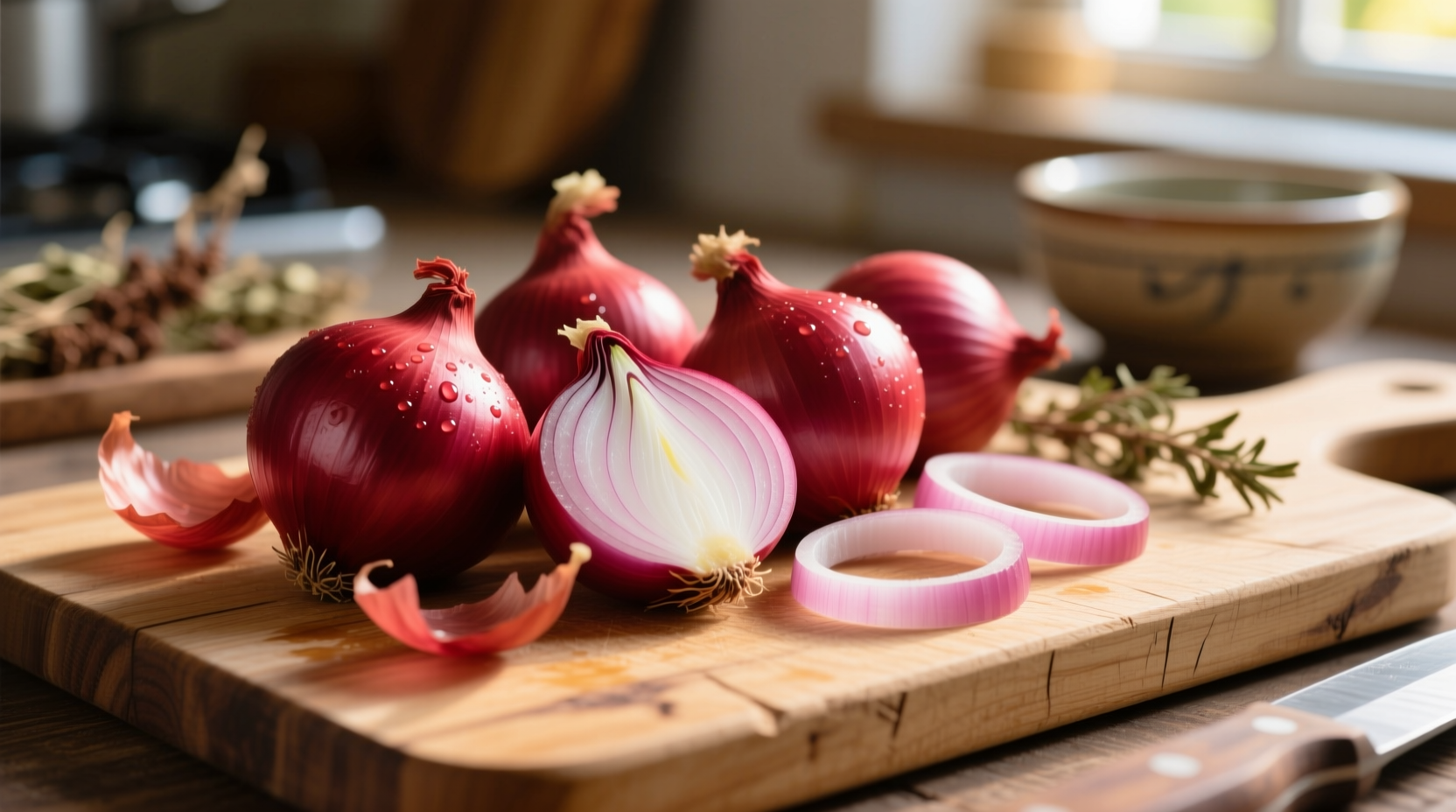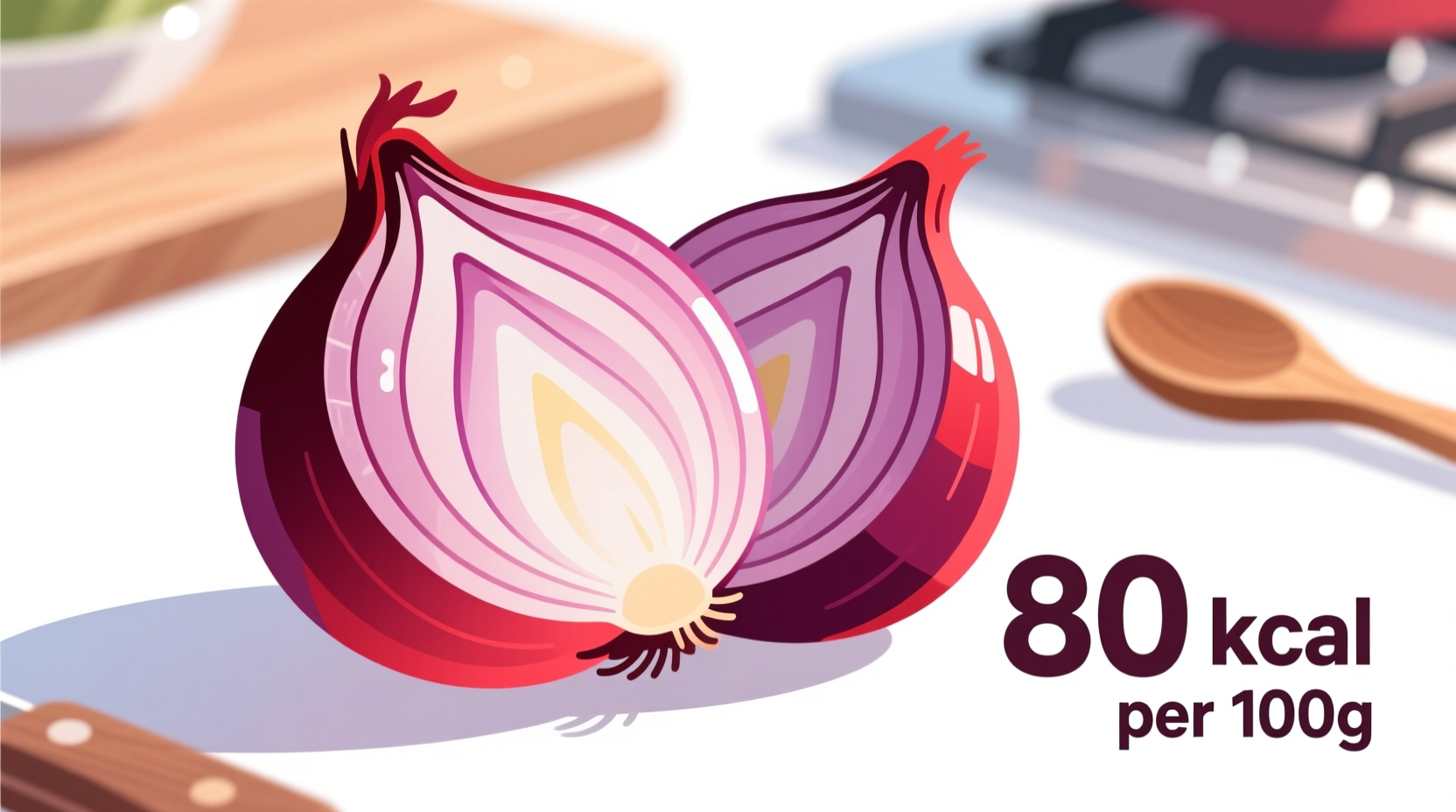Discover exactly how red onions fit into your nutritional plan with this comprehensive guide. Whether you're tracking calories for weight management, managing diabetes, or simply eating healthier, understanding the precise nutritional value of red onions helps you make informed food choices.
Nutritional Profile of Red Onions: What's Inside
Red onions aren't just colorful additions to your dishes—they pack a nutritional punch without adding significant calories. The USDA FoodData Central database confirms that a medium-sized red onion (approximately 110 grams) delivers:
| Nutrient | Amount per Medium Onion (110g) | % Daily Value* |
|---|---|---|
| Calories | 44 | 2% |
| Total Carbohydrates | 10.3g | 4% |
| Dietary Fiber | 2.0g | 7% |
| Sugars | 5.5g | - |
| Protein | 1.2g | 2% |
| Vitamin C | 11.8mg | 13% |
| Vitamin B6 | 0.16mg | 9% |
| Folate | 20mcg | 5% |
| Potassium | 196mg | 6% |
*Percent Daily Values are based on a 2,000 calorie diet. Your daily values may be higher or lower depending on your calorie needs.
Red Onion Calories Compared to Other Varieties
When tracking your calorie intake, understanding the differences between onion varieties helps you make precise dietary choices. All onions are naturally low in calories, but slight variations exist:
| Onion Type | Calories per 100g | Carbohydrates per 100g | Notable Characteristics |
|---|---|---|---|
| Red Onion | 40 | 9.3g | Higher in anthocyanins, slightly sweeter than white onions |
| White Onion | 42 | 9.7g | Sharper flavor, commonly used in Mexican cuisine |
| Yellow Onion | 40 | 9.3g | Most versatile, becomes sweet when cooked |
| Green Onions | 32 | 7.3g | Much lower in calories, primarily used as garnish |
| Shallot | 72 | 16.8g | Higher in calories and carbs, more intense flavor |
This comparison, based on USDA FoodData Central measurements, shows that red onions fall in the middle range for calorie content among common onion varieties. While the differences are minimal, they can matter when tracking calories precisely.
How Red Onion Calories Fit Into Your Daily Diet
With only 44 calories per medium onion, red onions represent less than 3% of a standard 1,500-2,000 calorie daily diet. This makes them an excellent choice for various dietary approaches:
- Weight management: Add flavor without significant calories—perfect for enhancing salads, salsas, and grilled dishes
- Diabetes management: The 10.3g of carbohydrates per medium onion fits within most carb-controlled meal plans
- Keto diets: While onions contain natural sugars, small portions (¼ onion = 11 calories) can work within keto macros
- Mediterranean diet: Red onions are a staple ingredient in this heart-healthy eating pattern
Registered dietitians at the Harvard T.H. Chan School of Public Health note that non-starchy vegetables like red onions should form the foundation of healthy eating patterns due to their low calorie density and high nutrient content.
Maximizing Health Benefits While Managing Calories

Red onions offer more than just low calories—they deliver significant health-promoting compounds. Research published in the Journal of Agricultural and Food Chemistry reveals that red onions contain higher levels of anthocyanins (the pigments that give them their purple color) compared to other onion varieties. These powerful antioxidants may help reduce inflammation and support heart health.
For maximum nutritional benefit while managing calories:
- Eat raw when possible: Raw red onions preserve more vitamin C and certain antioxidants that can degrade with cooking
- Pair with healthy fats: The fat-soluble compounds in red onions absorb better when eaten with avocado, olive oil, or nuts
- Don't overcook: Light cooking preserves more nutrients than prolonged high-heat methods
- Use as a flavor enhancer: Replace higher-calorie condiments with thinly sliced red onions for sandwiches and burgers
Practical Tips for Using Red Onions in Your Meal Planning
Understanding serving sizes helps you accurately track red onion calories in your diet. Here's how common preparations translate to calories:
- 1 medium red onion (110g): 44 calories
- 1 cup chopped red onion (160g): 64 calories
- 1 tablespoon chopped red onion (15g): 6 calories
- 1 thin slice (5g): 2 calories
When following recipes, remember that cooking concentrates flavors but doesn't significantly change calorie content. A cup of cooked red onions contains approximately the same calories as a cup of raw onions, though the volume decreases during cooking.
For those monitoring carbohydrate intake, the natural sugars in red onions (5.5g per medium onion) come with fiber that helps moderate blood sugar response. The American Diabetes Association recommends including onions in diabetes meal plans due to their low glycemic impact.
Storage Tips to Maintain Nutritional Value
Proper storage preserves both the flavor and nutritional content of red onions. To maximize shelf life and nutrient retention:
- Store whole, unpeeled onions in a cool, dark, well-ventilated place (not the refrigerator)
- Keep away from potatoes, which release gases that cause onions to spoil faster
- Once cut, store in an airtight container in the refrigerator for up to 7 days
- Freeze chopped onions for longer storage (though texture changes)
According to research from the University of California, Davis, proper storage helps maintain the antioxidant content of red onions. Exposure to light and heat can degrade some beneficial compounds over time.
Common Questions About Red Onion Nutrition
Understanding these frequently asked questions helps clarify how red onions fit into various dietary approaches:











 浙公网安备
33010002000092号
浙公网安备
33010002000092号 浙B2-20120091-4
浙B2-20120091-4